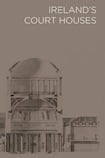
This handsome and profusely illustrated book draws our attention to something that we do not tend to notice much: the courthouses that are a significant element in the public architecture of Ireland and bind together the cities and towns of the island.
Judith Hill provides a keynote architectural history of Irish courthouses, amplified by the magnificent gazetteer of courthouses of Eve McAulay and Colum O’Riordan, both of the Irish Architectural Archive, which along with the Courts Service has contributed much to the publication.
The great age of the construction of Irish courthouses is the early 19th century. The most emblematic building, the Four Courts, belongs to the end of the 18th century, when James Gandon took over and refigured on the death of Thomas Cooley the incomplete building on Inns Quay that was under construction from 1785.
The Four Courts complex sustained terrible damage as effectively the site of the outbreak of the Civil War, when it was occupied by anti-treaties and laid siege to by the new Irish government. Threatened with demolition, it owes its survival to the enlightened perseverance of Thomas Joseph Byrne, chief architect of the Office of Public Works, who, fortified by a friendship with WT Cosgrave, successfully made the case for its reconstruction. It was Gandon also who provided the template for the neoclassical courthouses in the grand manner in Ireland, which derived from Gandon’s design of the magnificent courthouse in Waterford.
Construction economy
Hill gives an excellent account of the political economy of court-building in early 19th-century Ireland: the initiative lay with the Grand Jury of the county, whose members frequently aspired to the building in the public sphere of courthouses that matched the grace of Georgian private architecture, which was not always appreciated by the other cess-payers to whom it fell to pay for the construction. She notes there is some evidence that grand jurors prodded the architects in the direction of Greek revival designs.
To that, and possibly to the specific influence of John Foster, the last speaker of the Irish House of Commons, whose seat in both senses was in Louth, we may owe the magnificent Greek Revival courthouse in Dundalk. The 1813 contract stipulated that the details “shall be executed according to the patterns and true proportions of the Rules of Grecian Architecture as they are collected from the ruins of the City of Athens”, and cited James Stuart’s Antiquities of Athens. The book taps into a rich seam of architectural, legal and institutional history which will be mined further – Building the Irish Court House and Prison: a Political History, by Richard Butler, whom Hill cites, is eagerly awaited next year.
This is an architectural survey, and so does not address the diverse dramas that took place within the walls of these buildings, from the fate of those convicted of serious offences, to the elevation into the public sphere of justice of private disputes in rural and urban Ireland that could fester for generations. They were also major political theatres. The most politically haunted of Irish courthouses, that at Green Street (1797), has been “repurposed” but is intact. In the Parnell era, the issues of the land war, of early land purchase, and of Balfourian “coercion” were fought out as much within the court system across Ireland as at Westminster. After the 1916 Rising and during the War of Independence, the scene largely shifted to trials by courts martial which did not take place in courthouses.
Statement edifices
The Courts Service, established in 1999, has the probably thankless task of administering the Irish court system. A significant part of the purpose for which it was established was to take charge of the courthouses of Ireland. The middle part of the book is a description of the very considerable works that have been carried out to Irish courthouses.
Apart from the construction of the stand-alone courthouses, of which the most vast is the Criminal Courts of Justice on the edge of the Phoenix Park, these have typically involved the erection of large modern buildings which integrate the old courthouses. They are “statement” edifices, and at least in that respect maintain Gandon’s monumental ambitions.
There are interesting changes in internal conception: the criminal dock seems to have fallen foul of the presumption of innocence; four separate circulation routes are prescribed to avoid awkward or fractious encounters in the cavernous entrance halls of the classic Irish courthouse. But trials are still trials, and one wonders whether the balance between the preservation of Irish courthouses as still-active sites of historical memory and supposed imperatives of functionality has been got quite right.
Frank Callanan is a barrister and historian. He is completing James Joyce in Ireland: A Political Life












